How to write an outline for a persuasive speech
Giving persuasive speeches isn't just for high school and college composition classes. You may already give
persuasive speeches and not know it. Even if you're not formally presenting persuasive speeches, it's important to
know how to present your ideas in such a manner. A format exists for outlining your thoughts in a persuasive
speech. The format exists for a reason. It is a logical and powerful means of presenting your views.
Instructions
o 1 Select your topic. The more specific the topic, the better.
o 2 Set guidelines. You already know that you want to persuade. Now choose specifically what you
want to persuade the listener to do. A speech to advance an idea is different than a speech that
motivates the listener to action.
o 3 Get the listener's attention. Fill the listener with a sense of urgency.
o 4 Establish credibility. Explain to the listener why he should listen to you on this subject.
o 5 Make a definite statement. Your speech should have what is called a "thesis." A thesis is a clearly
defined, one-sentence statement that sums up your argument.
o 6 Summarize your points. Explain why your subject is of urgent need. Tell the listener how she can
help solve the problem. Outline the difference between a positive resolution and a negative resolution.
Finally, leave the listener with a sense of how he can make a difference.
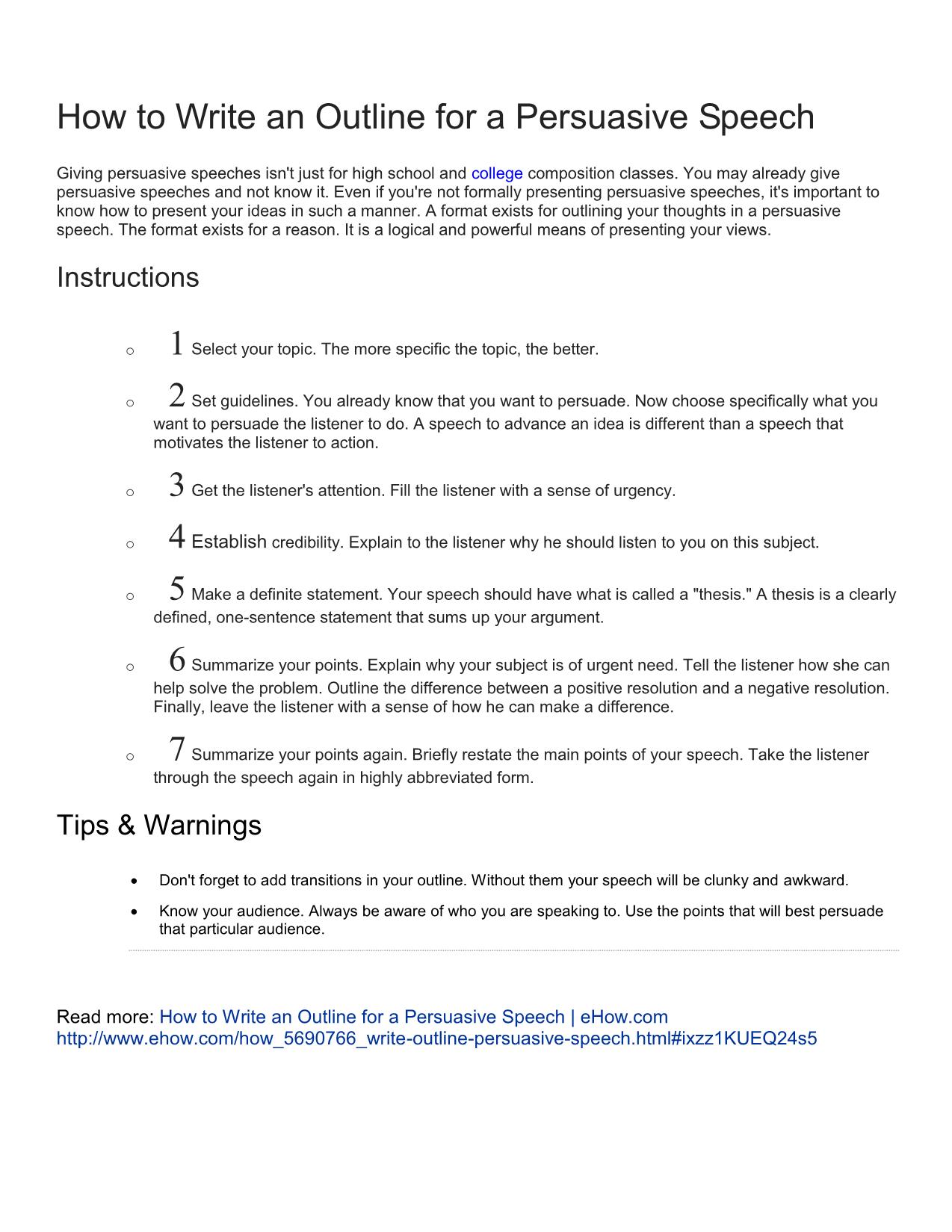
Trang 1
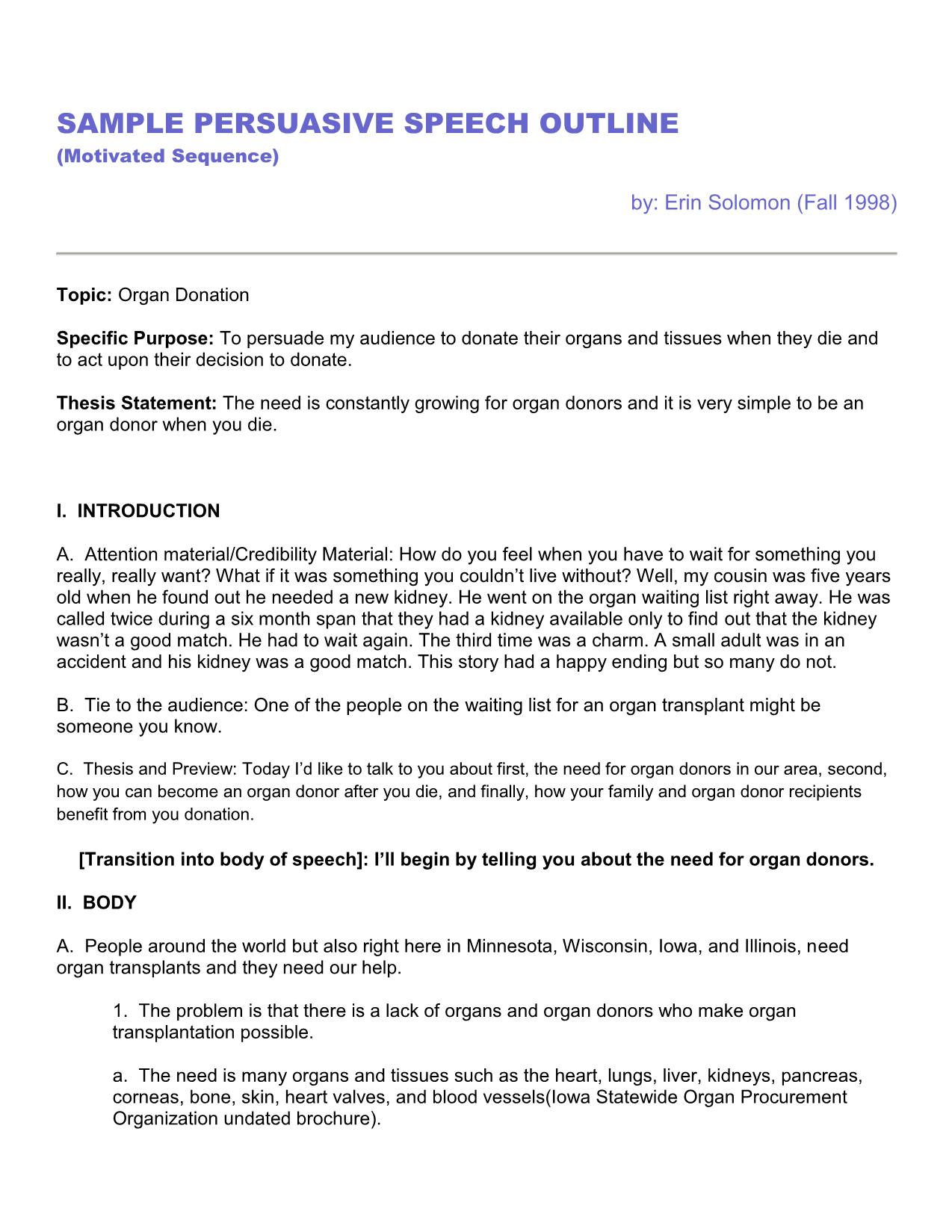
Trang 2
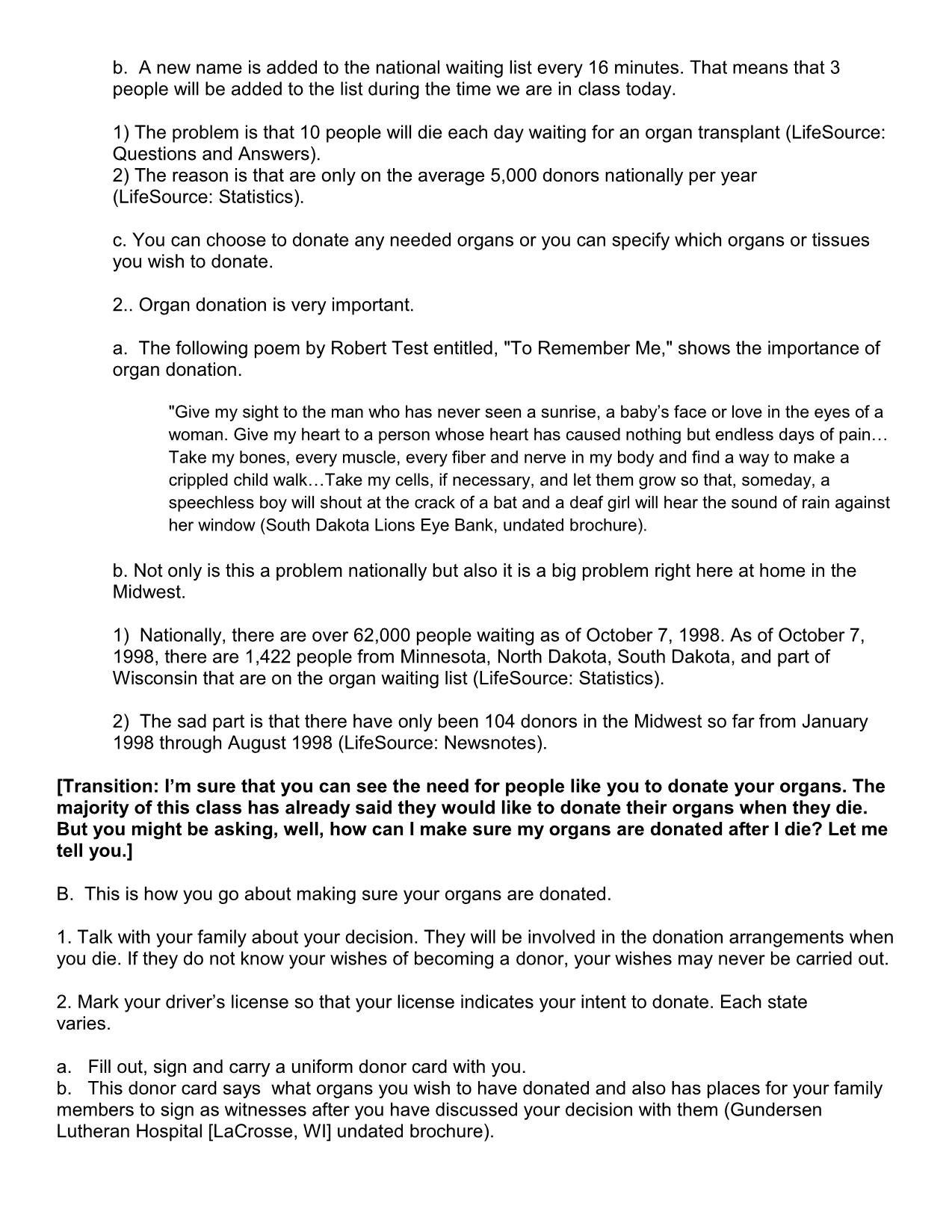
Trang 3
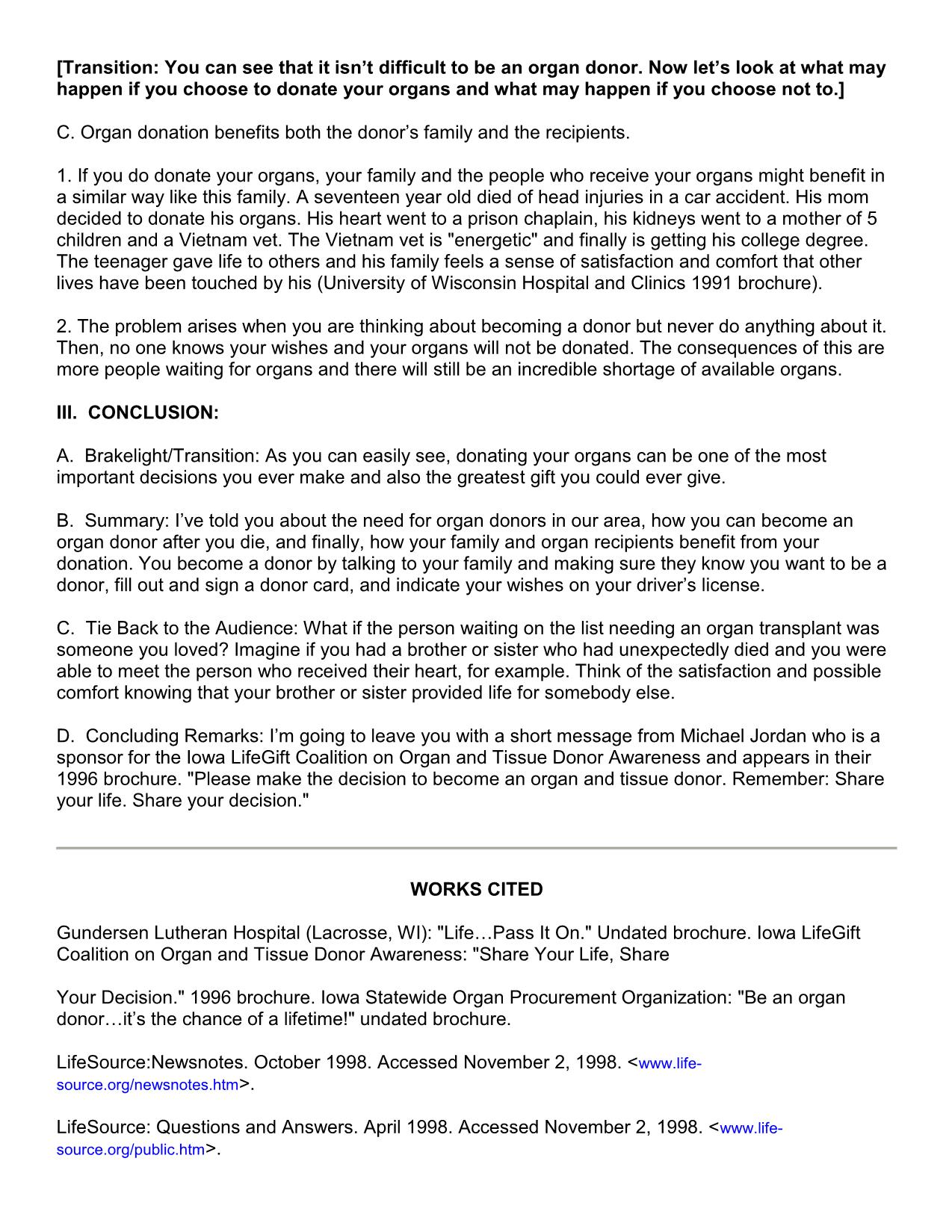
Trang 4
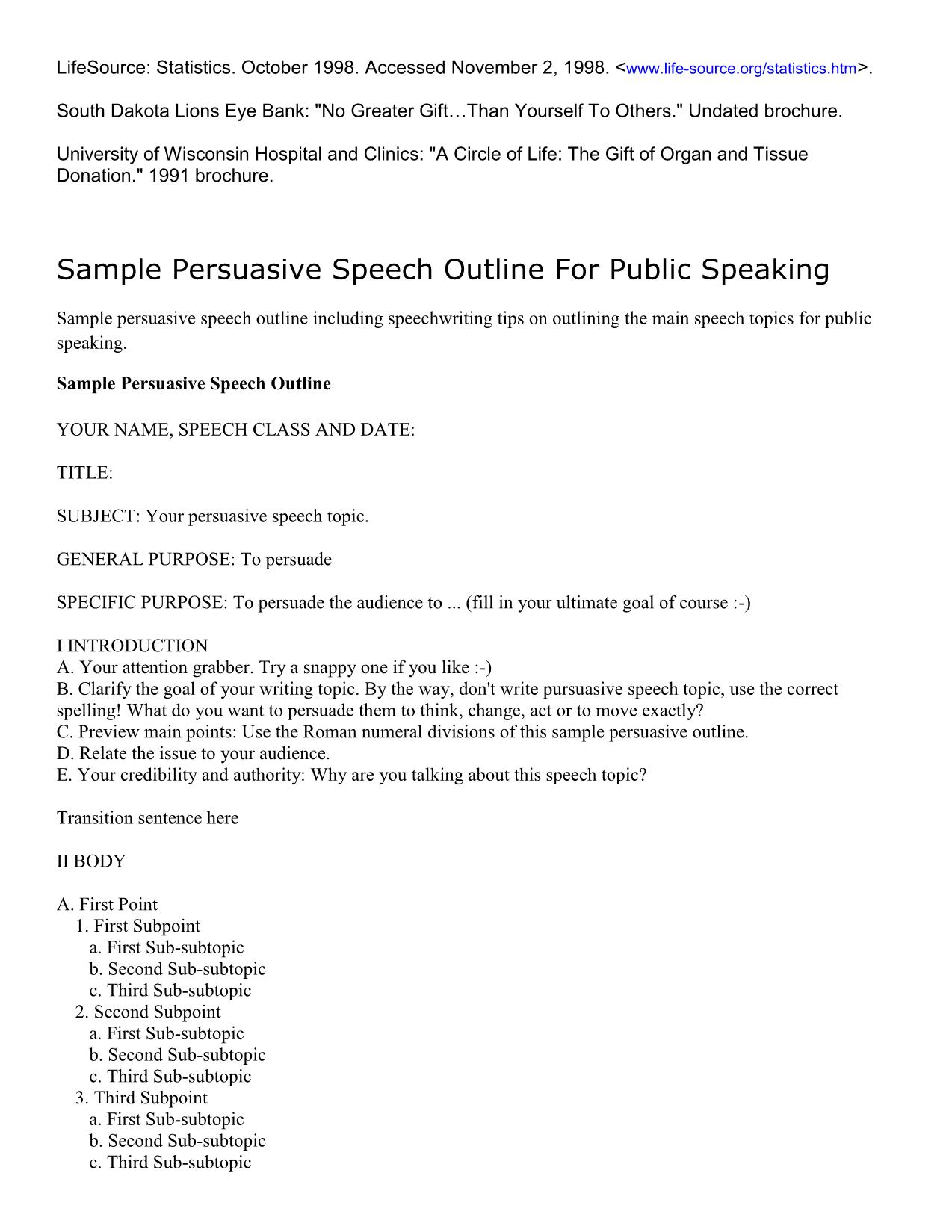
Trang 5
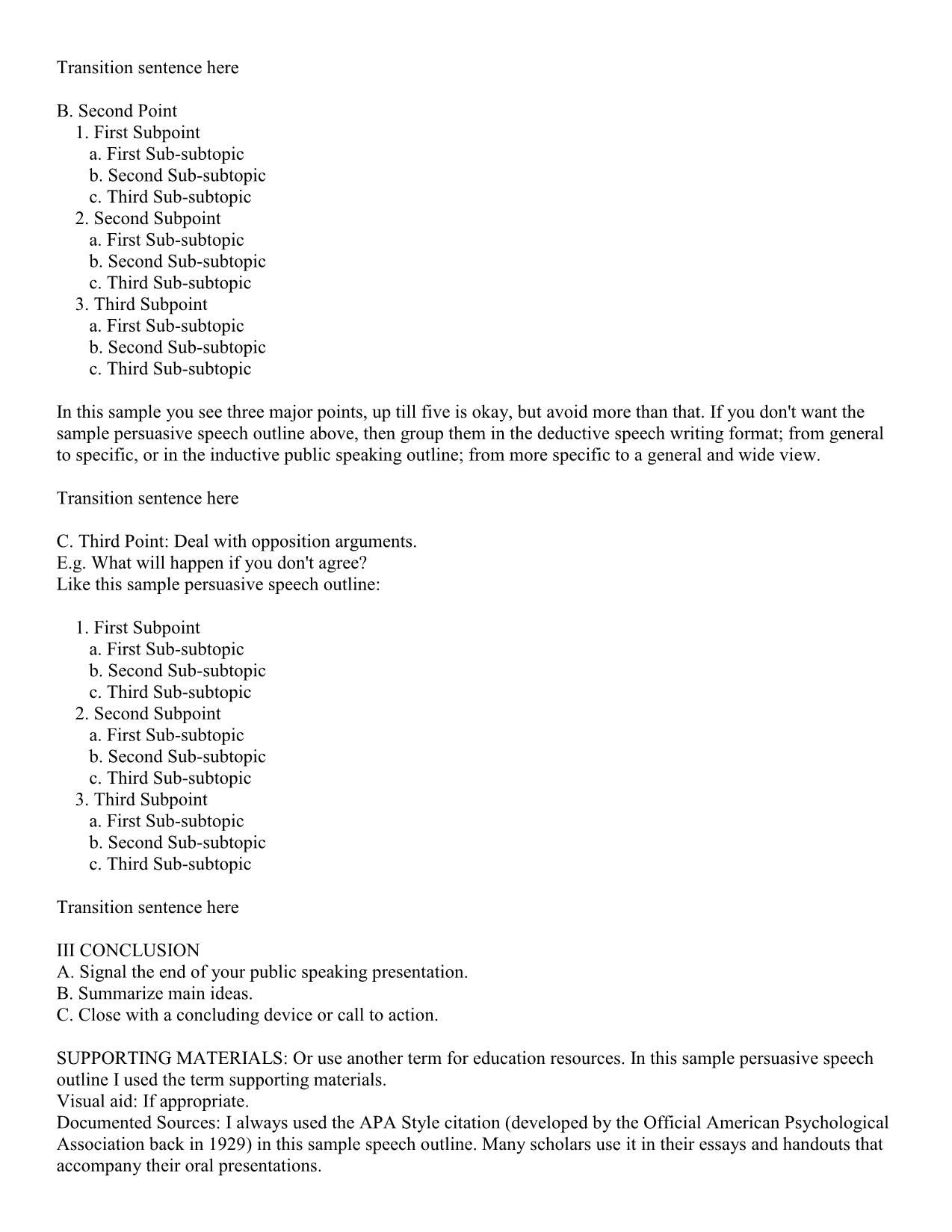
Trang 6
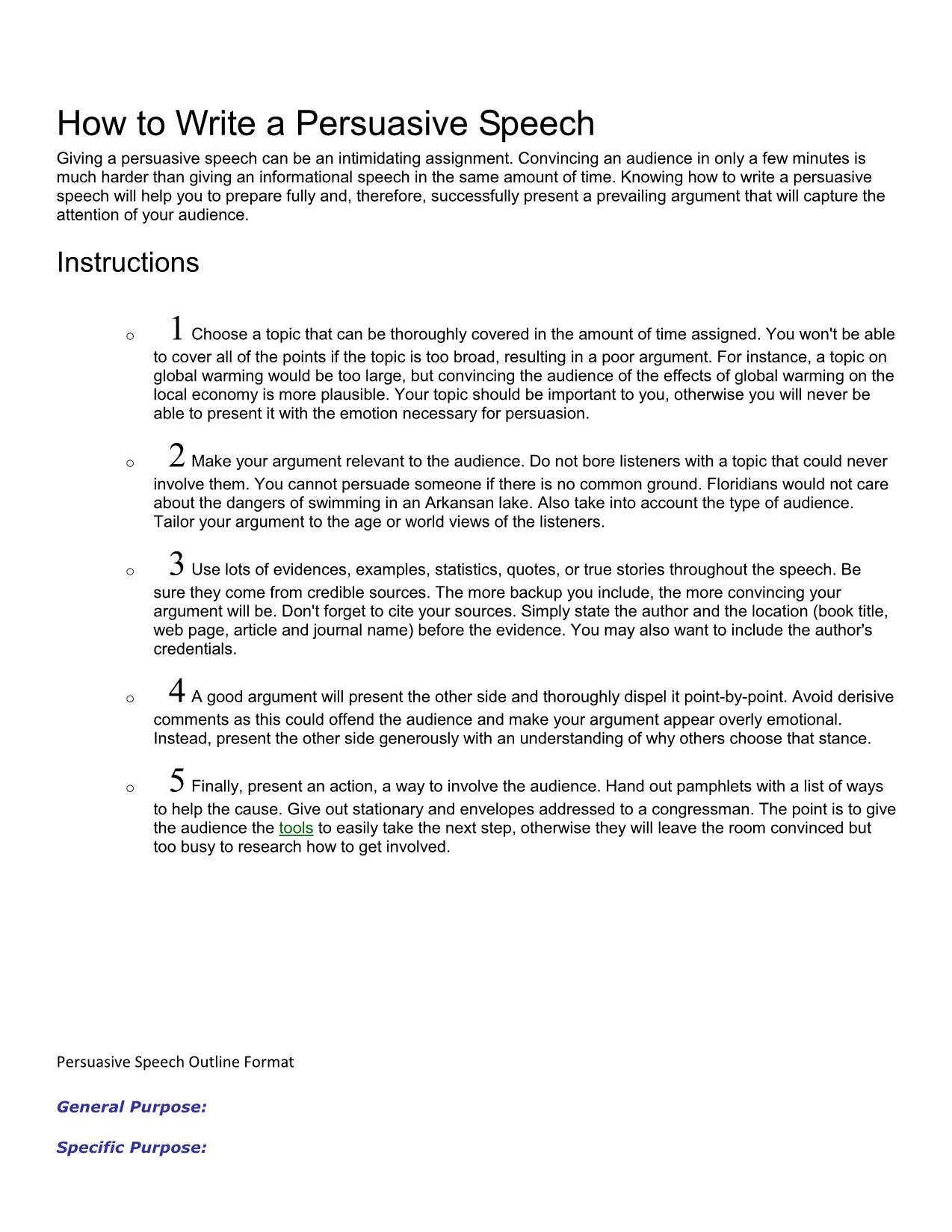
Trang 7
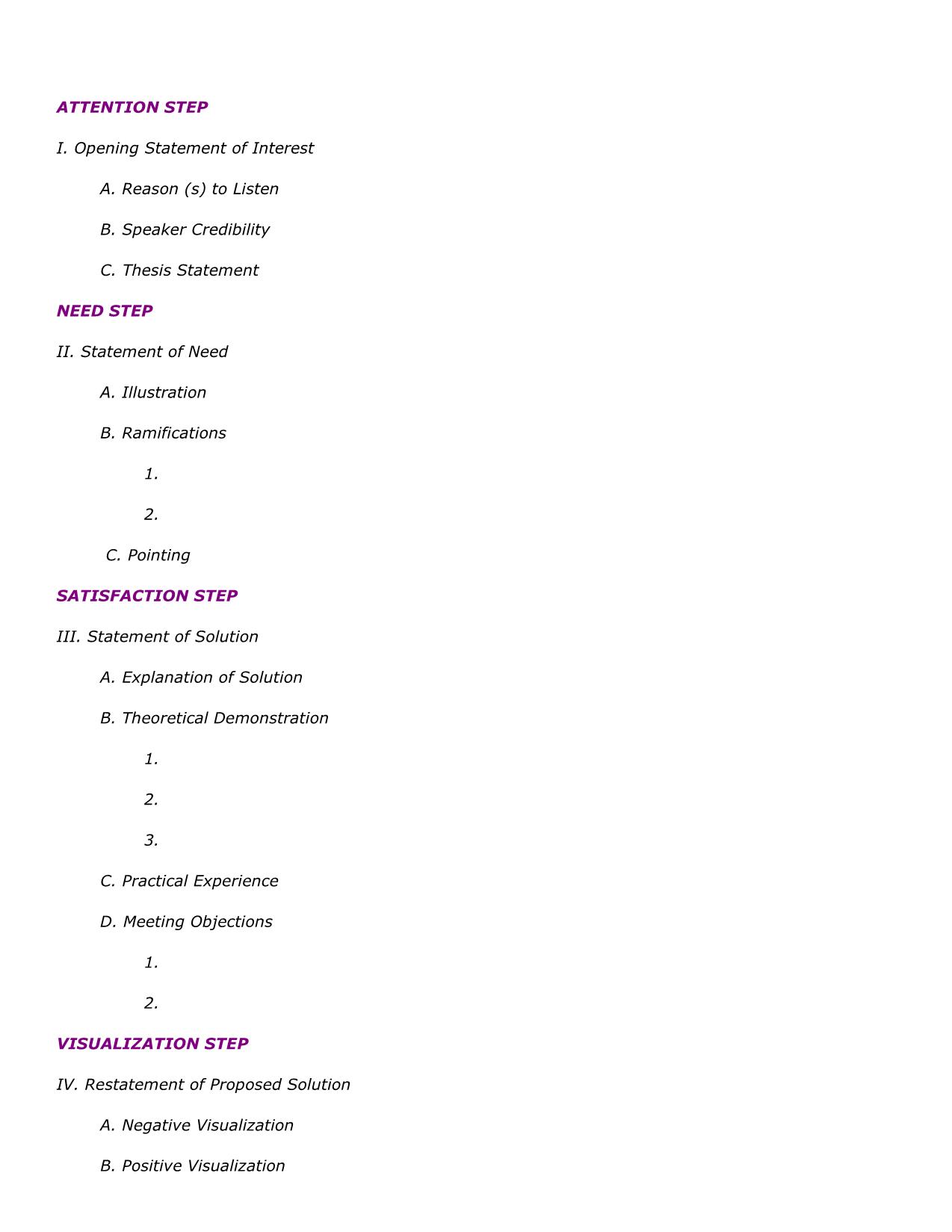
Trang 8
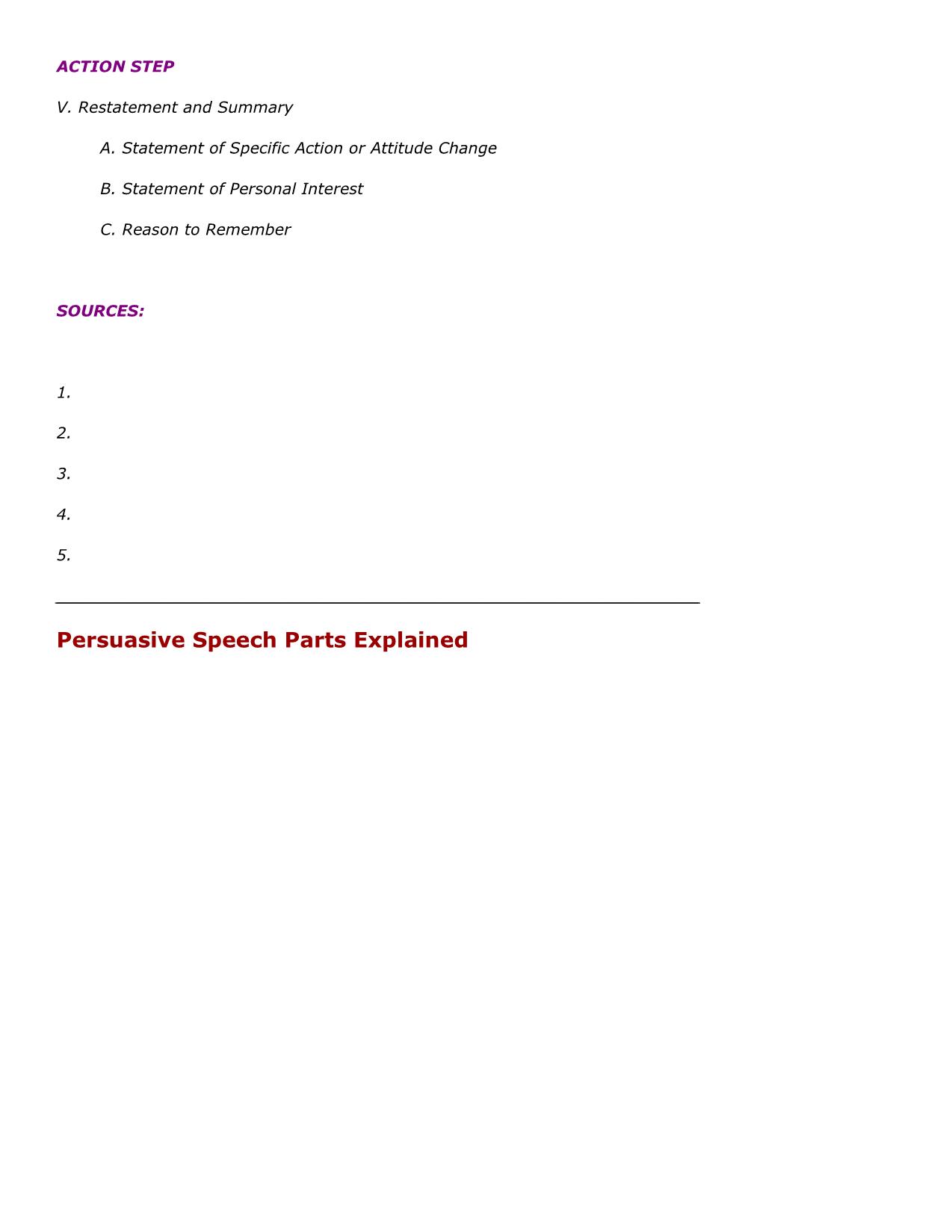
Trang 9
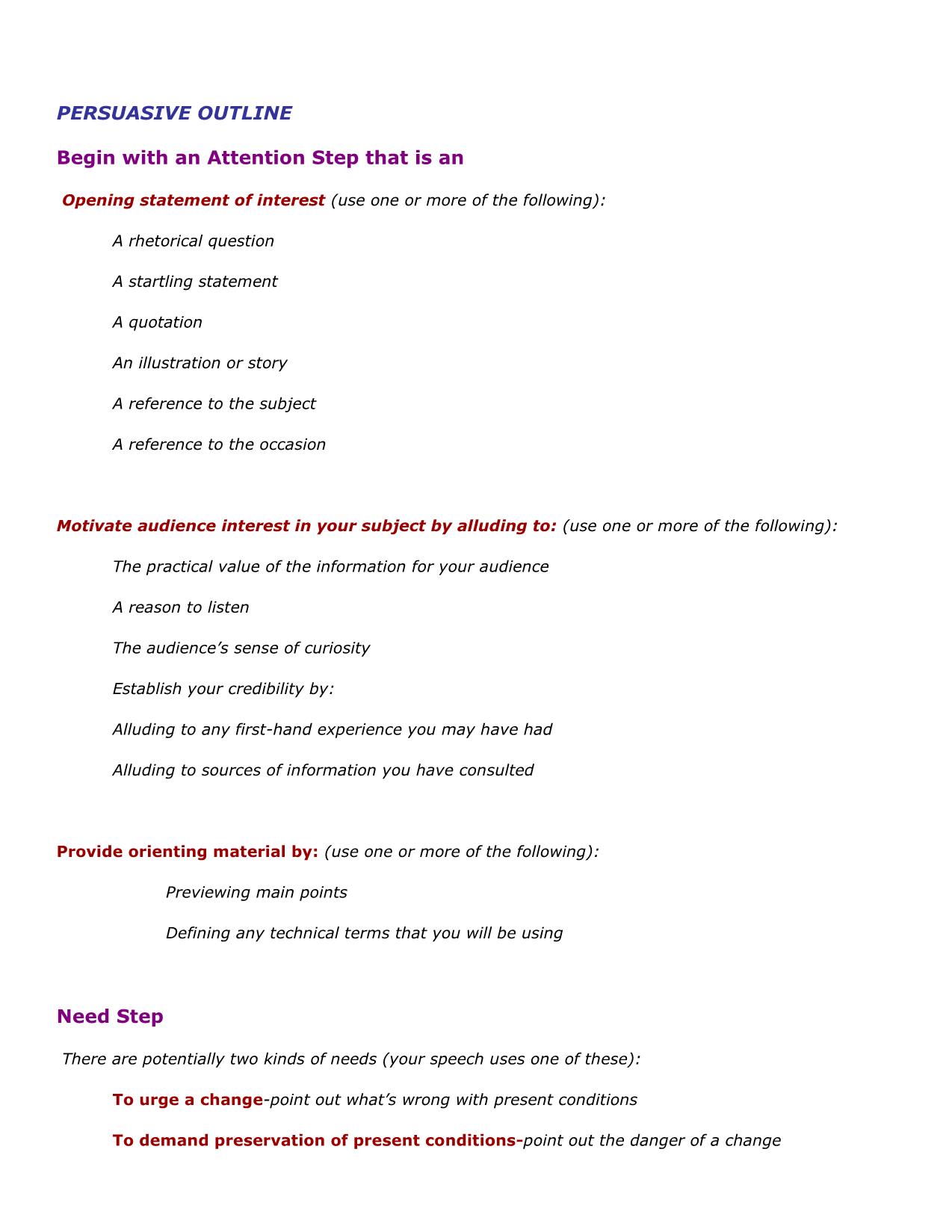
Trang 10
Tải về để xem bản đầy đủ
Tóm tắt nội dung tài liệu: How to write an outline for a persuasive speech
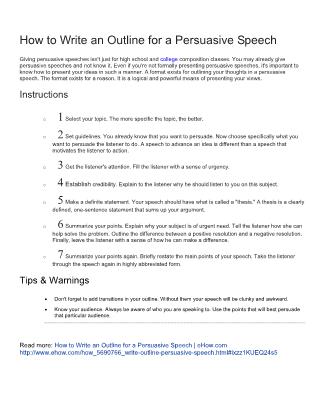
How to Write an Outline for a Persuasive Speech Giving persuasive speeches isn't just for high school and college composition classes. You may already give persuasive speeches and not know it. Even if you're not formally presenting persuasive speeches, it's important to know how to present your ideas in such a manner. A format exists for outlining your thoughts in a persuasive speech. The format exists for a reason. It is a logical and powerful means of presenting your views. Instructions o 1 Select your topic. The more specific the topic, the better. o 2 Set guidelines. You already know that you want to persuade. Now choose specifically what you want to persuade the listener to do. A speech to advance an idea is different than a speech that motivates the listener to action. o 3 Get the listener's attention. Fill the listener with a sense of urgency. o 4 Establish credibility. Explain to the listener why he should listen to you on this subject. o 5 Make a definite statement. Your speech should have what is called a "thesis." A thesis is a clearly defined, one-sentence statement that sums up your argument. o 6 Summarize your points. Explain why your subject is of urgent need. Tell the listener how she can help solve the problem. Outline the difference between a positive resolution and a negative resolution. Finally, leave the listener with a sense of how he can make a difference. o 7 Summarize your points again. Briefly restate the main points of your speech. Take the listener through the speech again in highly abbreviated form. Tips & Warnings Don't forget to add transitions in your outline. Without them your speech will be clunky and awkward. Know your audience. Always be aware of who you are speaking to. Use the points that will best persuade that particular audience. Read more: How to Write an Outline for a Persuasive Speech | eHow.com SAMPLE PERSUASIVE SPEECH OUTLINE (Motivated Sequence) by: Erin Solomon (Fall 1998) Topic: Organ Donation Specific Purpose: To persuade my audience to donate their organs and tissues when they die and to act upon their decision to donate. Thesis Statement: The need is constantly growing for organ donors and it is very simple to be an organ donor when you die. I. INTRODUCTION A. Attention material/Credibility Material: How do you feel when you have to wait for something you really, really want? What if it was something you couldn’t live without? Well, my cousin was five years old when he found out he needed a new kidney. He went on the organ waiting list right away. He was called twice during a six month span that they had a kidney available only to find out that the kidney wasn’t a good match. He had to wait again. The third time was a charm. A small adult was in an accident and his kidney was a good match. This story had a happy ending but so many do not. B. Tie to the audience: One of the people on the waiting list for an organ transplant might be someone you know. C. Thesis and Preview: Today I’d like to talk to you about first, the need for organ donors in our area, second, how you can become an organ donor after you die, and finally, how your family and organ donor recipients benefit from you donation. [Transition into body of speech]: I’ll begin by telling you about the need for organ donors. II. BODY A. People around the world but also right here in Minnesota, Wisconsin, Iowa, and Illinois, need organ transplants and they need our help. 1. The problem is that there is a lack of organs and organ donors who make organ transplantation possible. a. The need is many organs and tissues such as the heart, lungs, liver, kidneys, pancreas, corneas, bone, skin, heart valves, and blood vessels(Iowa Statewide Organ Procurement Organization undated brochure). b. A new name is added to the national waiting list every 16 minutes. That means that 3 people will be added to the list during the time we are in class today. 1) The problem is that 10 people will die each day waiting for an organ transplant (LifeSource: Questions and Answers). 2) The reason is that are only on the average 5,000 donors nationally per year (LifeSource: Statistics). c. You can choose to donate any needed organs or you can specify which organs or tissues you wish to donate. 2.. Organ donation is very important. a. The following poem by Robert Test entitled, "To Remember Me," shows the importance of organ donation. "Give my sight to the man who has never seen a sunrise, a baby’s face or love in the eyes of a woman. Give my heart to a person whose heart has caused nothing but endless days of pain Take my bones, every muscle, every fiber and nerve in my body and find a way to make a crippled child walkTake my cells, if necessary, and let them grow so that, someday, a speechless boy will shout at the crack of a bat and a deaf girl will hear the sound of rain against her window (South Dakota Lions Eye Bank, undated brochure). b. Not only is this a problem nationally but also it is a big problem right here at home in the Midwest. 1) Nationally, there are over 62,000 people waiting as of October 7, 1998. As of October 7, 1998, there are 1,422 people from Minnesota, North Dakota, South Dakota, and part of Wisconsin that are on the organ waiting list (LifeSource: Statistics). 2) The sad part is that there have only been 104 donors in the Midwest so far from January 1998 through August 1998 (LifeSource: Newsnotes). [Transition: I’m sure that you can see the need for people like you to donate your organs. The majority of this class has already said they would like to donate their organs when they die. But you might be asking, well, how can I make sure my organs are donated after I die? Let me tell you.] B. This is how you go about making sure your organs are donated. 1. Talk with your family about your decision. They will be involved in ... After adding your attention story, edit your speech further again and try not to add last minute ideas. Practice your speech publicly, in a small group. Perform it in front of people who agree with your perception of the subject. Welcome their feedback and any obstacles that they might think will become visible. Edit your speech again for any changes, always adjusting the size of your speech for the time allowed. Also, do not stand in one spot (unless on camera), as moving around a bit will help to keep your audience focused because it establishes a sense of interactivity. Engage your audience with your movements and eye contact. Look directly at individuals in your audience, changing your gaze every so often. If a few particular audience members smile in response, remember them as a focal point. They may provide visual support and encouragement if you falter a bit during your speech. Practice your speech again privately, in front of the mirror. Try to learn your speech as much as you can to where your notes are mainly just to keep you on track. What your expressions and your mannerisms, make sure that you use voice inflection and that you have emotion in your speech. If there is no emotion in your voice or body, more than likely, there won't be any in the audience either. Dress appropriately for the gathering where your speech will be held. Be confident, caring, and humble. Give your speech. Prepare yourself ahead of time with your own positive encouragement and praise. If you find it helpful, give yourself verbal encouragement in front of a mirror. Alternatively, seek the encouragement of a friend or co-worker. How to Write a Persuasive Speech If you did your outline correctly, then writing your speech should be a matter of plugging in the extra information. This is how many writers can put out multiple works within a small period of time. How to write a persuasive speech. 1. Choose a topic In terms of persuasion, your topic must be grounded in literature. This is a necessity because when people are presented with an argument, they always want to hear the evidence. Therefore it would be beneficial to have a lot of pre-written literature to support your speech. It would also help if the topic you choose is politically neutral. This avoids creating animosity within the audience that would make for heated panel discussion after your speech, additionally your are trying to persuade your audience not piss them off! You should also know your audience. This would greatly help in deciding the topic and how to convey the speech, obviously a college seminar would be much different from an investment speech. 2. Research your topic After choosing a topic that interest you, the next step is to read up on the topic. This provides knowledge base which is key to fluid speaking. Some great places to start your research includes, Lexis Nexus, Jstor, Google Scholar, and Project Muse. You should never speak on a topic that you have a predisposed bias towards. This means your research is limited if you do. Statistics show that people look for evidence that supports their points not vice versa, hence an objective mind during the research stage helps convey an unbiased message. 4. Outline your speech The outline is crucial to prevent writers block at any stage. Your outline should be clear and contain a claim, warrant, and impact for everything associated with your line of reasoning. The outline happens to be the easiest part of the preparation for a persuasive speech. Your intro should allude to your points. All of your points should be independent containing all the necessary parts for an argument that I previously indicated. 5. Write your speech If you did your outline correctly, then writing your speech should be a matter of plugging in the extra information. This is how many writers can put out multiple works within a small period of time. The 10 Step to Writing a Persuasive Speech Step 1: Determine your Topic. When Brainstorming, keep this in mind about your topic: 1. Your topic should be something you feel strongly about. 2. The speech needs to meet the time requirements. 3. The topic needs to have at least two conflicting views. • Speeches to Convince - You want your audience to agree with your way of thinking. You aren’t asking listeners to “do” anything. This approach is especially good when your listeners initially disagree with your position and you realize that moving them to action is unlikely. • Speeches to Actuate - You want your audience to take action. 4. Topic you already know a lot about. Step 2: Determine your Position Statement. Your Position Statement is your thesis. It will take one of three forms: • Statement of Value - “Something is or is not good.” This is personal opinion. Example: “It is IMMORAL to use animals for medical research.” • Statement of Fact - “Something is or is not true.” This is less personal opinion and can be backed up by credible research. Example: “Nuclear power plants are a SAFE energy source.” • Statement of Policy - “Something should or should not be done.” Example: “Drugs should be legalized.” Step 3: Analyze Audience Attitudes Using the Opinion Continuum. Everybody falls into one of the seven categories of the Opinion Continuum when confronted with a controversial topic: Hostile / Opposed / Mildly Opposed / No Opinion / Mildly in Favor / In Favor / Highly in Favor If you project that most of your audience is in favor of your topic, than recommend a specific course of action. There is no need to spend valuable speech time to convince an audience of something they already believe. There are three reasons an audience may have no opinion about a topic: 1. They are uninformed. (The speaker should inform them). 2. They are neutral. (The speaker should give good arguments and credible sources). 3. They are apathetic. (The speaker needs to motivate them). If an audience is slightly opposed, then the speaker should approach them directly by presenting good reasons and evidence. If an audience is hostile to the topic, then the speaker should seek a slight change in attitude, attempting to get them to understand the speaker’s point of view. Step 4: Mindmap and Outline. Where do you need sources? Step 5: Research. • Find evidence for both sides of the topic. • Think about audience concerns and address them. Step 6: Choose an Organizational Pattern. Your book writes about several persuasive organizational patterns is Chapter 18, but I’m going to focus on the five that I find to be most effective: Problem-Solution, Direct Method, Comparative Advantage, Negative Method, and Monroe’s Motivated Sequence. Problem-Solution The Problem-Solution pattern is probably the most commonly used persuasive speech pattern. The first part of the speech is spent explaining the problem to the audience, while the second half is devoted to offering a solution. Intro: Position Statement: There are too many air disasters. (Position of Fact). I. There are too many air disasters and near disasters around the globe. A. The problem of near-misses and crashes is serious. 1. It is extensive (stats). 2. This has negative implications for travelers. B. There are several causes of this problem. 1. There are communication problems between crews and air traffic controllers. 2. Weather is a consideration. 3. Mechanical and maintenance failures cause disasters. II. The problem can be minimized. A. Airplanes should be more carefully inspected and maintained. B. Both crew members and air traffic controllers should continue to receive on-the-job training both in communication and in understanding the effects of weather. C. Engineers and researchers should continue to develop state-of-the-art equipment to prevent some of these disasters. Conclusion: Direct Method In the Direct Method, you make a claim then directly state your reasons to support it. Each point, thus, provides an additional rational to agree with your views. It is a good pattern to use when listeners are apathetic or neutral, mildly favoring, or mildly opposing the claim. Often it is used when the major persuasive purpose is to convince, though it can also be used to organize a speech to actuate. In the Direct Method, the speaker should begin with the least important reason and end with the most important. Intro: Position Statement: Everyone should drive 55 miles per hour. (Position of Policy) I. It will save fuel. II. It will save money. III. It will save lives. Conclusion: Comparative Advantages Pattern A Comparative Advantages pattern shows that one proposal is superior to competing proposals by comparing its advantages to those of the competition. Intro: Position Statement: Fords are better than any other vehicles. (Position of Value) I. Ford has a better repair record than its competitors. II. Ford has a higher resale value that its competitors. III. Ford is more economical than its competitors. Conclusion: Negative Method Pattern When you use the Negative Method, you concentrate on the shortcomings of every other proposal; then you show why your proposal is the one logical solution remaining. This is used with Positions of Policy. Intro: Position Statement: Drugs should be legalized. (Position of Policy) I. More drug enforcement agencies are not the answer. II. Better education is not the answer. III. Incarceration is not the answer. IV. Global legalization of drugs is the only way we will regulate supply and demand. Conclusion: Monroe’s Motivated Sequence Alan Monroe, a professor at Purdue University for many years, developed and refined a pattern that is commonly used in persuasive speaking, especially in speeches with the purpose of actuating behavior. As you will see, it is a modified form of a problem-solution speech. In order to move people to act, it is necessary to motivate them to do what they know they should do. Because of this, it is important to provide emotional reasons as well as logical ones. Attention Step. At the outset of the speech, as in any speech, you must gain the audience’s attention and draw it to the speech topic. Need Step. This step is similar to the problem part of a problem-solution speech. Dr. Monroe suggests four elements in establishing the need: 1. Statement-Tell the nature of the problem. 2. Illustration-Give a relevant detailed example (or examples). 3. Ramifications-Provide additional support such as statistics or testimony that show the extent of the problem. 4. Pointing-Show the direct relationship between the audience and the problem. What are the personal implications for each listener? Satisfaction Step. After you have demonstrated the problem, how extensive it is, and how it will affect the audience, propose a solution that will satisfy the need you have created. This step can have as many as five parts: 1. Statement-Briefly state the attitude, belief, or action you want the audience to adopt. 2. Explanation-Make your proposal understandable; visual aids may help at this point. 3. Theoretical demonstration-Show the logical connection between the need and your solution. 4. Practicality-Use facts, figures, and testimony to show that the proposal has worked effectively or that the belief has been proved correct. 5. Meeting Objections-Here you show that your proposal can overcome any potential objections that listeners might have. Visualization Step. This step is unique from the patterns we have seen so far. In it, you ask the audience to imagine what will happen if they enact the proposal or if they fail to do so. 1. Positive-Describe future conditions when the plan is put into action. Put the audience into a realistic scenario, enjoying what your solution has provided. In this section, you commonly appeal to pathos (safety needs, pride, pleasure and other emotions). 2. Negative-Have the listeners imagine themselves in an unpleasant situation because they did not put the solution into effect. 3. Contrast-Compare the negative results of not enacting the plan with the positive results the plan will produce. Action Step. In the final step, call for the listeners to act in a specific way. 1. Call for an overt action, attitude or belief. 2. State your personal intention to act. 3. End with impact. Step 7: Come up with Introduction and Conclusion. Introduction: You need to gain the attention of your audience within the critical first two minutes. Avoid opening any presentation with “Good morning or afternoon or evening” or a sentence such as “It’s a pleasure to be here.” Sometimes presenters begin with “Good morning” and then wait for the audience to answer back, but the response doesn’t come because the audience has heard the same thing from the three previous speakers. The usual greetings are so overdone that people literally tune them out. Instead, start out with the unexpected. Open your talk with an unusual or funny quotation, an amusing story, or a fascinating statistic. Conclusion: Ties your introductory comments to your conclusion. Leave your audience with a closing thought that either calls them to action or inspires them to do something. Avoid closing with “Thank you” or “That’s all.” Step 8: Build Credibility. 1. Tell the truth. 2. Keep information (especially stats) in perspective. 3. Resist personal attacks. 4. Give the correct source citations. Step 9: Prepare Visual Aids & Speaking Notes. Visual aids should enhance a speech, not distract from it. Please refer to your textbook (p. 356-363) to learn more about visual aids. Your speaking notes should be a key word outline and not a script. Step 10: Rehearse, Rehearse, Rehearse!
File đính kèm:
 how_to_write_an_outline_for_a_persuasive_speech.pdf
how_to_write_an_outline_for_a_persuasive_speech.pdf

